Santa Clara County Master Gardeners Visit the Coyote Valley Specialty Pepper Plots and Monterey Mushrooms
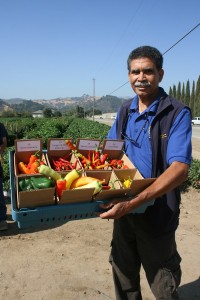
On August 19, 2014, the Discover Coyote Valley Initiative partnered with the U C Cooperative Extension and Amega Farm Company to host an informational seminar on “Learning how to Conduct a Research Experiment in Agriculture” for the Santa Clara County Master Gardener Program. Located on the corner of San Bruno and Hale Avenues, Mr. Aziz Baameur used the chili pepper farm trials as a real life experiment to describe the proper scientific methods to conduct an agricultural research experiment.
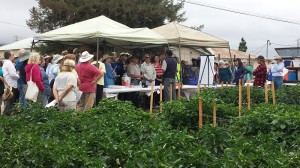
With over 70 attendees, Linda Baity, Santa Clara County Master Gardener Program Coordinator with the University of California Cooperative extension, stated “There are more than a dozen demonstration sites throughout Santa Clara County. Master Gardeners are learning more about the scientific methods for clinical trials, collecting scientific results and applying it to their work with home gardeners. “ Patrick Day, Master Gardener Co-Lead Member of the Education Committee shared with us that “this morning’s presentation was important for Master Gardeners to learn about how to perform trials. We need to standardize how we conduct and record trials.”
There were 68 varieties of chili peppers that were shared with participants to see, smell and touch. In the chili pepper trial, the experiment look at varied water, nitrogen and potassium treatments, how they were measured and how that affected plant size and fruit output. Mr. Baameur also shared information about California Irrigation Management Information System (CIMIS), a program unit in the Water Use and Efficiency Branch, Division of Statewide Integrated Water Management, California Department of Water Resources (DWR) that manages a network of over 145 automated weather stations in California. This unit allows the measurement of evapo-transpiration of the plant and soil in gallons per acreage.
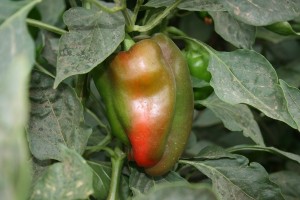
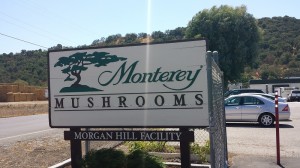
In the afternoon, Master Gardeners headed over to Monterey Mushrooms located on 642 Hale Avenue in Morgan Hill CA for a 1.5 hour tour of the facility to learn all about the mushroom growing process. In groups of 25 and after removing all jewelry, we were fully equipped with fluorescent vests and head protection and ready to learn about the 21 day cycle of mushrooms.
It all begins with the compost. The compost is comprised of 75% day old wheat straw that has been used by horses from a nearby racetrack and 25% of wheat straw soaked in water to inoculate the composting process. For the first 5 days, dried chicken waste, urea and water is added to the compost. Every 2-3 days, the compost is turned so it does not become anaerobic. It is then heated to 170 degrees of higher to caramelize. Then, it needs to pasteuriz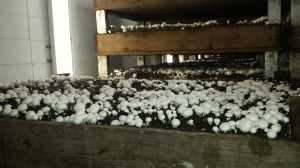 e at 140 degrees; this kills the bad microbes and keeps the good ones. Finally, the temperature is cooled to 85 degrees and water and supplemental food is added. Within the next two weeks, the dark brown color becomes red. Now, there is a sweet smell and a layer of peat moss and sugar beet lime is added. The room temperature is now at 75%. The mushroom culture is manipulated to grow thru the peat moss causing mushroom pinning to flower. Now, they have either Baby Bellas (brown) or white mushrooms. The mushrooms are hand-picked for the largest ones. The ones left will double in size overnight. This happens for three harvests before the soil goes to get heated and goes to compost.
e at 140 degrees; this kills the bad microbes and keeps the good ones. Finally, the temperature is cooled to 85 degrees and water and supplemental food is added. Within the next two weeks, the dark brown color becomes red. Now, there is a sweet smell and a layer of peat moss and sugar beet lime is added. The room temperature is now at 75%. The mushroom culture is manipulated to grow thru the peat moss causing mushroom pinning to flower. Now, they have either Baby Bellas (brown) or white mushrooms. The mushrooms are hand-picked for the largest ones. The ones left will double in size overnight. This happens for three harvests before the soil goes to get heated and goes to compost.
The tour was fun and educational. The Santa Clara County Master Gardeners learned that Monterey Mushrooms is second generation, family-owned and operated agribusiness with a passion for excellence about 450 employees with 50 employees salaried and 400 farmers. Monterey Mushrooms, Inc. was established in 1971 as a family- owned and operated farm in Royal Oaks, California. Today, Monterey is vertically integrated and able to control all aspects of mushroom production from seed to customer/consumer.
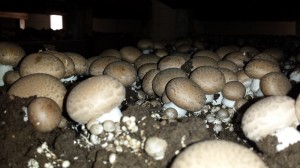
Comments are closed.